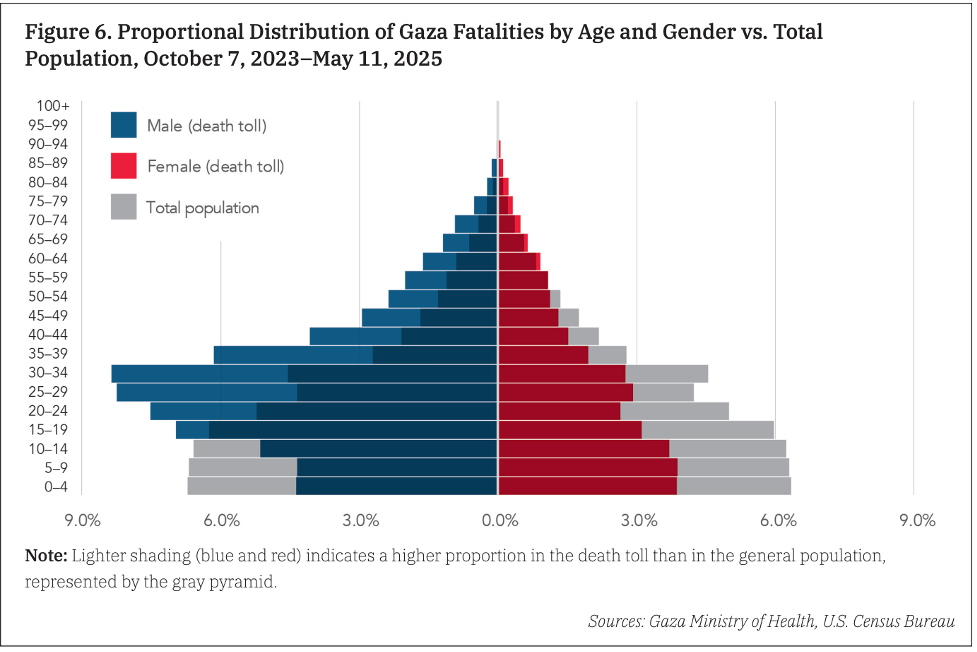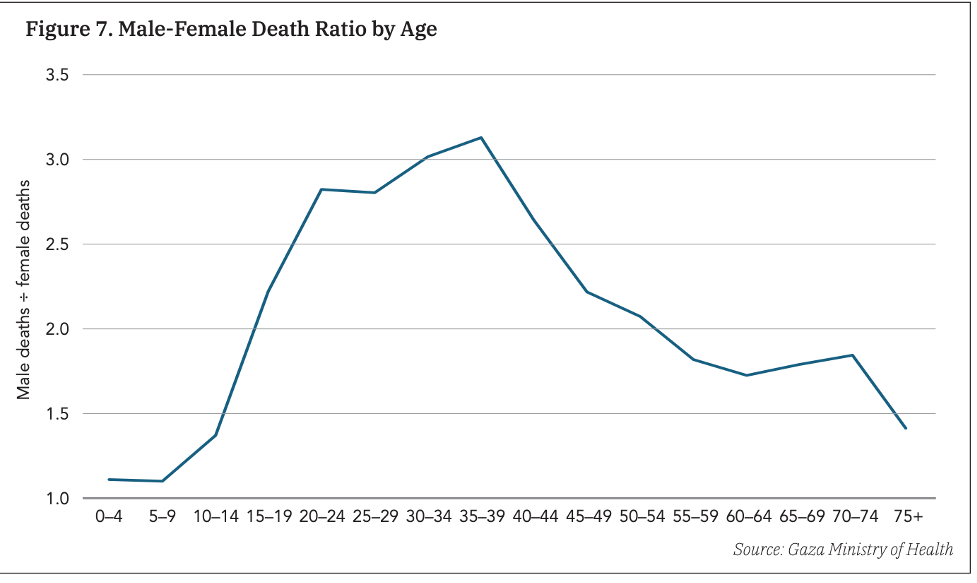Scribblings: Interpreting Hamas’ casualty numbers
Last month, the AIR published an article by Ben-Dror Yemini discussing new research showing that even the casualty data from Gaza produced by the Hamas-controlled Ministry of Health there, questionable though this is, makes it clear Israeli forces are not acting indiscriminately or ‘genocidally’ in their attacks in Gaza.
The Hamas statistics show that combat-age men are far more likely to be killed, compared to their proportion of the population, than women, children or the elderly. Hamas data doesn’t differentiate between combatants and civilians, but the only sensible explanation for these numbers is that Israel is doing its best to target combatants. However, as is always the case in intense urban warfare, civilians still die as collateral damage. This is particularly true in Gaza because not only is it densely urban, but Hamas deliberately riddled all civilian neighbourhoods, and most civilian public buildings such as schools, mosques, hospitals, kindergartens and clinics, with military tunnels, rocket launch sites, weapons caches, bunkers, command and control centres and explosive booby-traps.
However, what the Hamas casualty data shows can be difficult to comprehend through a verbal explanation alone, so I am grateful for the latest study on the subject of Gaza casualties put out by Washington Institute for Near East Policy expert Gabriel Epstein. Not only does Epstein’s new paper, “Assessing the Gaza Death Toll After Eighteen Months of War”, examine the Hamas casualty data comprehensively and professionally, it illustrates the key points with some excellent graphs that make things much easier to visualise. I include two key examples below.

Figure 6, above, shows the actual casualty numbers compared to what they would be if Israel was actually killing Gazans indiscriminately. The grey areas represent Palestinian women and children who would be dead if Israel was killing Palestinians without trying to target combatants. The light blue represents the gross over-representation of largely combat-age men in the Hamas numbers.
Figure 7 makes things even more clear:

To explain what this means, if men and women were being killed in equal numbers, this graph of the male:female ratio of those killed by age would show a completely straight line across the bottom at the “1.0” level. But this graph is nothing like that. Men, especially combat-age men, are many times more likely to have been killed than their female relatives, as the peaks of the graph illustrate.
Overall, according to Epstein, the combat-age male cohort, that is 18 to 45, are 2.85 times more likely than women of the same age to be killed. At some age levels, it is over three times more likely.
To be clear, of course, we must never forget that these numbers represent an utterly tragic reality for many individuals and families – even if a large fraction of those killed have been Hamas or other terrorist group combatants, and even if the ratio of civilians to combatants killed appears arguably better than similar recent examples of urban warfare. There is every reason to want the war to end and the killing to stop as soon as possible – but only in such a way that it is not going to start up again in a few years. But this requires Hamas to be disarmed and removed from power.
The point is that Hamas’ own casualty numbers debunk the claims of those who are prepared to help keep Hamas in power by falsely accusing Israel of supposedly targeting civilians.
Since it seems to be too much to ask for the mainstream media to stop treating the questionable Hamas casualty numbers as definitive, is it too much to ask that they at least explain that these same numbers actually debunk the pro-Hamas claim that Israel is killing Palestinians indiscriminately?
Primed for “Genocide”
I was recently perusing a copy of the Australia/Israel Review from June 1994, and came across an article by a then-young researcher named Tzvi Fleischer. It dealt with problematic coverage of the Middle East at that time on SBS, Australia’s multicultural public broadcaster, discussing problems of media bias that seem similar to those that still persist today. However, one item in particular, really made me think “the more things change, the more they remain the same.”
On Dec. 13, 1993, SBS had broadcast the documentary “Connections: My prison, my home,” a hagiographic and completely one-sided biography of Palestine Liberation Organisation activist Raymonda Tawil. But what struck me about it is the documentary accused Israel of “genocide” of the Palestinians (the context used to justify the accusation was the building of settlements in the West Bank).
Wow, where have I heard that before? And this “genocide” claim on Australian TV occurred without the context of Palestinians actually dying in conflict with Israel, as they sadly are today. In fact, the context was the height of the Oslo peace process, in the immediate aftermath of the Rabin-Arafat handshake on the White House lawn on Sept.13, 1993.
This 1993 “genocide” charge provides a perfect illustration of the way the word “genocide” was always inevitably going to be at the core of the anti-Israel slogans employed by pro-Palestinian activists, after Hamas launched a war with the Jewish state through the mass terrorist atrocities of October 7, 2023. “Genocide” claims have been a key weapon in the Palestinian war on Israel’s existence for decades. They actually apparently derive originally from pro-Palestinian propaganda put out by the Soviet Union in the 1960s and 1970s.
The point is that most of those – in Arab, Muslim and far-left circles – leading the charge to label Israel’s actions in Gaza “genocide” are not doing so because they saw the tragic suffering of the Palestinian people in Gaza since Hamas launched the current war, and came to the conclusion only “genocide” can explain it. They are doing so because they have been primed for decades to scream “genocide” whenever the Israeli-Palestinian conflict is discussed.
